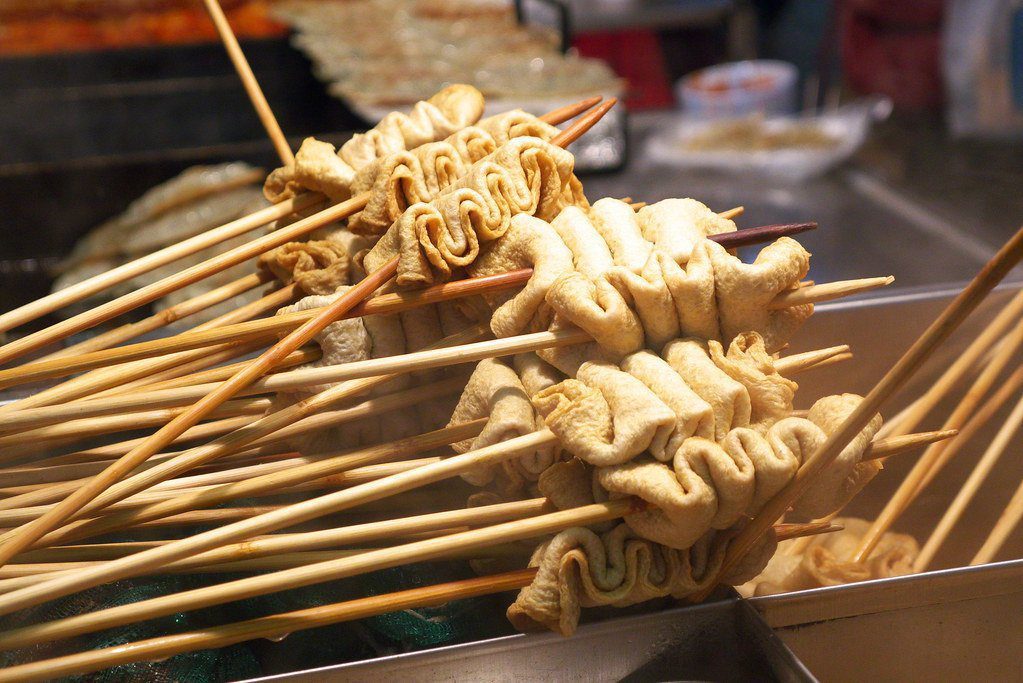If you’re into Korean dramas, you’ve probably seen “odeng” pop up as a popular street food. It’s the go-to snack for K-drama lovers, especially when you enjoy it piping hot with a tasty broth. So, what exactly is these food, and what’s it made of? Let’s dive in.
Getting to Know Odeng
In simple terms, odeng is a “fishcake” in English. It usually comes as thin slices skewered on sticks, looking like satay sticks you’d enjoy with chicken porridge.
You can easily find these food at street vendors, often alongside other Korean goodies like kimbap and tteokbokki. It’s also available in supermarkets, convenience stores, and restaurants.
The main ingredient is ground fish meat, often using various sea fish like haddock and cod. This fish mix is combined with rice or regular flour, salt, sugar, and rice wine. The result is a slightly chewy, tender, and savory snack with a distinct fishy aroma.
These thin, flat slices are then skewered on long bamboo sticks, often in a wave-like or stacked pattern. Odeng comes in different presentations, but it’s most commonly enjoyed with a clear, refreshing broth.

Oden or Odeng: What’s the Difference?
Both “oden” and “odeng” are right, but they refer to different things. Here’s the lowdown:
Oden
Oden hails from Japan and is part of the “nabemono” family, known for being a one-pot hot pot dish. These food typically features various fishcake products, vegetables, eggs, tofu, and other goodies simmered in a fish-based broth seasoned with soy sauce.
It’s a hit during the chilly winter months and has that unmistakable aroma of simmering broth you’d find at street food stalls. In Japan, “oden” covers dishes with a variety of ingredients, from fish to veggies.
Odeng
Now, Korean odeng is believed to have its roots in Japanese oden. Busan, a city in South Korea, is known as the place where it was first introduced and modified to suit Korean taste buds.
The term in Korea specifically refers to the fishcake itself, served with clear broth. In Korean, you might also hear “eomuk” used for this fish treat, although “odeng” is the more popular term.
These food have popularity in South Korea skyrocketed, especially after a protein crisis following the Korean War. During tough times, people sought more affordable sources of protein. Much like in Japan, odeng is a wintertime favorite, adored by young Koreans who often grab it from street vendors.
Different Flavors of Korean Odeng
Now, there are three main types of Korean odeng to keep in mind:
- Boiled: This is the most common type you’ll come across. It made from ground fish and flour, is simmered in a broth flavored with spring onions, radish, and either crab or dried seaweed. You’ll often get a separate soy sauce for dipping. Street vendors love selling this one.
- Sauced: To stand out in the competitive odeng market, some vendors offer sauced. In this version, odeng is rolled, fried, and served with various sauces like tomato sauce and mustard. For the spicy lovers, you can dip it into a tangy tomyam sauce.
- Tang: Also known as “eomuk guk,” this fishcake is served in a bowl of broth with sliced spring onions, soy sauce, and chili. This one’s more of a main course than a snack. It somewhat resembles Japanese oden in looks, even though the seasonings are totally different.
Why Do They Sell It Alongside Tteokbokki?
In Korea, street vendors usually have odeng right next to tteokbokki, and there’s a good reason for it. Tteokbokki is famous for its chewy rice cakes in a spicy sauce that can leave your ears tingling and your body sweaty.
Pairing with its warm broth next to tteokbokki is thought to help balance out the spiciness. This way, you can savor your tteokbokki without worrying about the heat, whether you sip the broth or take a bite of odeng.
